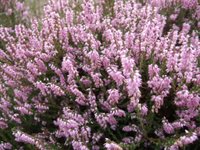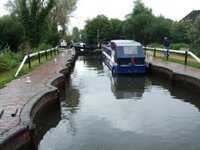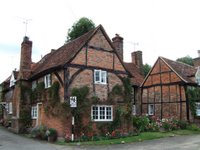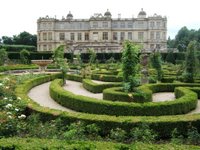 An excellent way to avoid Bank Holiday Monday traffic was to tour the edge-of-the-world highway across the top of Scotland.
An excellent way to avoid Bank Holiday Monday traffic was to tour the edge-of-the-world highway across the top of Scotland.We set out at 7am to catch the sunshine, which was only promised for the morning. The first highlight of the morning was the Whaligoe Steps. These are 365 steps leading down to a tiny harbour. At the peak of the herring fishing era women used to carry baskets of herrings up the steps from the harbour. The entire flight of steps is wide enough for two-way traffic. There is not really a harbour at the foot of the steps, just a small bay with sheer cliffs all around, so the men sometimes had to chain their boats to the cliff to keep them safe from storms. There were no problems when we visited, as the weather was perfect.
 The next highlight was a trip, out on a headland from Wick, to Castle Sinclair. Time has made this stronghold of power into a picturesque monument.
The next highlight was a trip, out on a headland from Wick, to Castle Sinclair. Time has made this stronghold of power into a picturesque monument. 
After that it was on to John O’Groats. This is not the most northerly point of mainland Britain but is probably the most northerly town so is treated as the top in all the “from Land’s End to John O’Groats” type phrases. It is equally miss-able as Land’s End. The rain arrived as we did, so we took the obligatory photo and left.
 We saw an advertisement regarding the Queen Mum's holiday home (read Castle) which is on the north coast of Scotland. She spent two holidays at the Castle of Mey every year after she bought and restored it in 1952 just after she was widowed. The sun once again shone brightly, as we looked around the castle and gardens.
We saw an advertisement regarding the Queen Mum's holiday home (read Castle) which is on the north coast of Scotland. She spent two holidays at the Castle of Mey every year after she bought and restored it in 1952 just after she was widowed. The sun once again shone brightly, as we looked around the castle and gardens. From there we drove through sun and rain all around the north and west coast of the Highlands. During the sunny spells, we visited the Smoo Cave, and the Falls of Shin. Smoo Cave is a huge limestone cave by the sea and just upstream the river that created it simply disappears down the proverbial ‘hole in the ground’. The Falls of Shin were fascinating in that we managed to see salmon leaping up the waterfall.
From there we drove through sun and rain all around the north and west coast of the Highlands. During the sunny spells, we visited the Smoo Cave, and the Falls of Shin. Smoo Cave is a huge limestone cave by the sea and just upstream the river that created it simply disappears down the proverbial ‘hole in the ground’. The Falls of Shin were fascinating in that we managed to see salmon leaping up the waterfall. The day was rounded off with the very Scottish meal of Haggis, Neaps & Tatties.
The day was rounded off with the very Scottish meal of Haggis, Neaps & Tatties.































